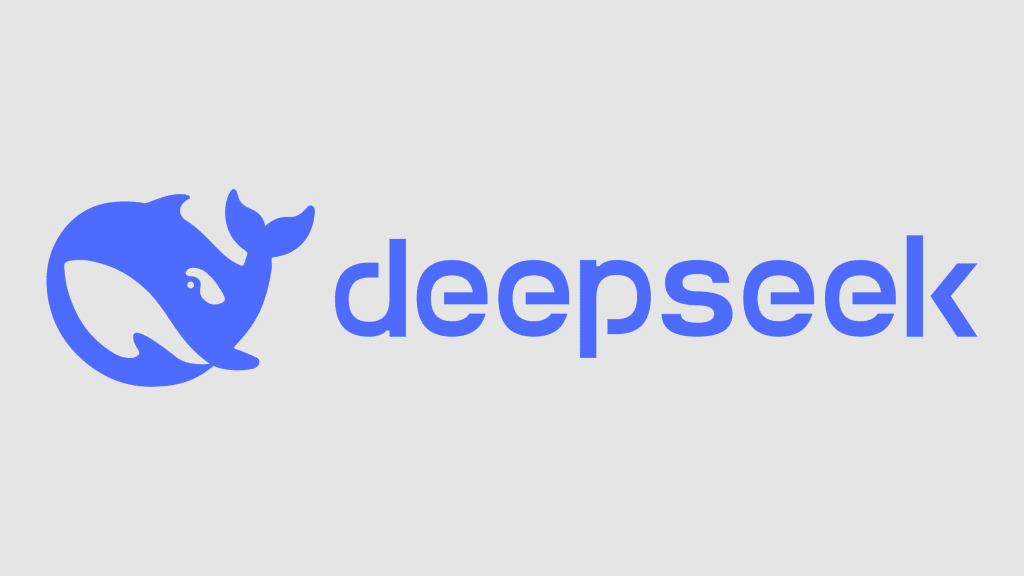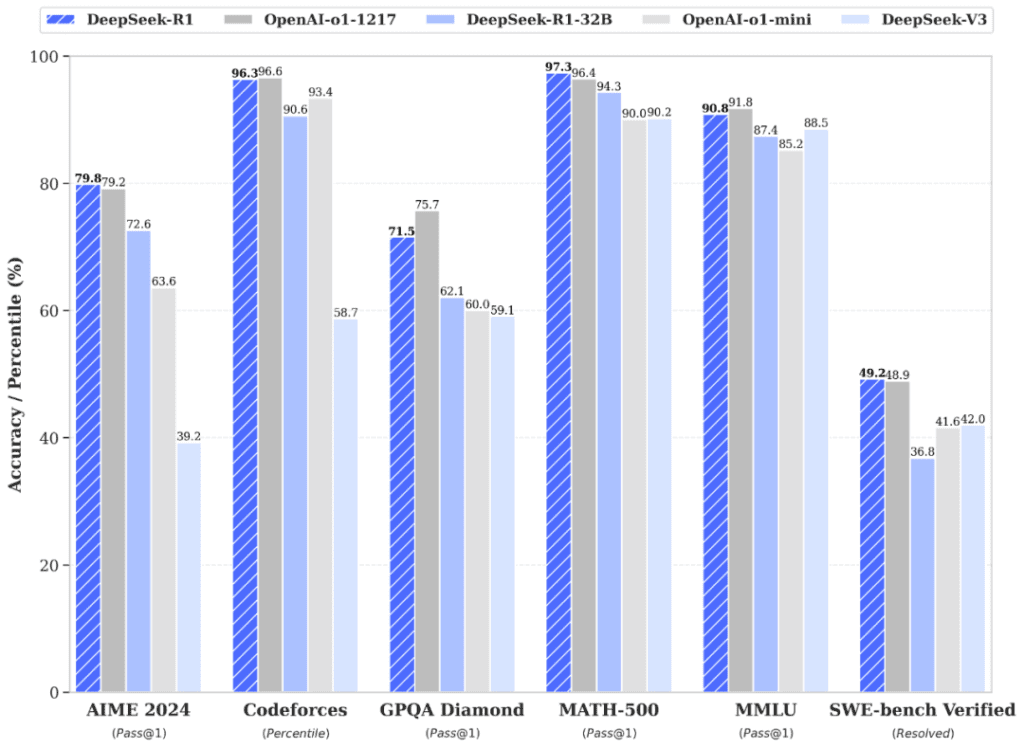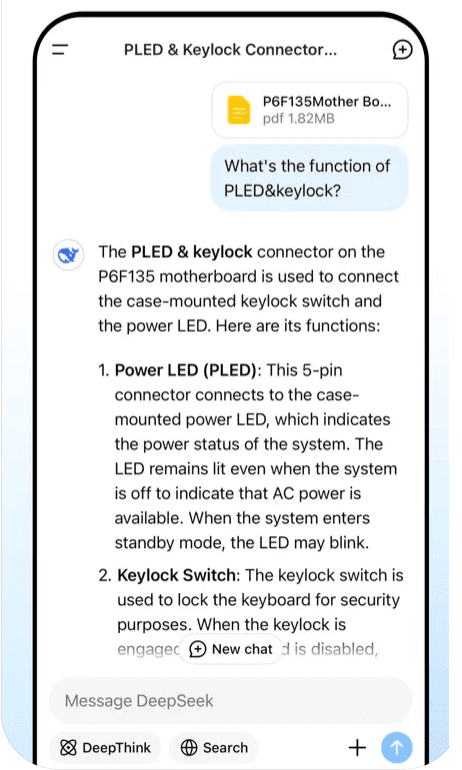What is DeepSeek? The Marketer’s Guide to the Impact of DeepSeek AI
If there is one lesson that marketers have learned in the past few years, it’s this – staying skeptical of new technology can be an expensive mistake. AI has become one of the most dominant technologies in marketing, and staying ahead means embracing popular AI tools that are reshaping the industry. Fresh in the AI landscape is DeepSeek, the latest innovation making waves in the marketing space.
The buzz around this new AI tool has been one of the biggest sensations in the industry this month. So, what does this new disruptive AI tool mean for marketers? How does this tool compare against some of the already popular AI tools in marketing workflows, like ChatGPT, Gemini, and others? We aim to answer all these and more in this blog.
So, without further delay, let’s delve into the marketer’s guide to the impact of DeepSeek AI.
What is DeepSeek?
If you aren’t already up to speed, then here’s a quick recap for you.
DeepSeek is a China-based independent AI research company that recently became the talk of the town. While the company itself was launched in 2023, what made it a viral sensation was the launch of the DeepSeek chatbot powered by their R1 reasoning model.
DeepSeek-R1 quickly became known as one of the worthiest contenders of some of the best in the segment like OpenAI’s AI models. Its performance in various benchmarks has been impressive, showcasing its ability to handle complex reasoning tasks with ease.
The fact that some of the sophisticated features like reasoning which are available in other AI models with paid plans are available in the currently free plan from DeepSeek is what shook up the scene. So much so, that major players like NVIDIA saw their stocks plummet. The Guardian even called this the “Sputnik Moment” in the world of AI, highlighting the seismic shift DeepSeek has caused.
One of the most notable aspects of DeepSeek is its push for truly “open” AI. While many companies claim to be open-source, DeepSeek is emerging as a genuine threat to those who have been criticized for not staying true to their open-source ethos. Additionally, DeepSeek’s models are trained at a relatively lower cost and in less time, making it a cost-effective and efficient alternative to its competitors.
The DeepSeek App
The DeepSeek app is available both for iOS and Android devices. Unlike other AI giants such as OpenAI, Google, or Meta, who typically introduce their AI models behind paywalls or limited access, DeepSeek has taken a different route.
Launched in early 2025, the DeepSeek app became an instant hit dethroning even market leaders like ChatGPT in Apple’s App Store.
Powered by their reputed V3 model with over 600B parameters, this app can tackle a wide range of complicated tasks including solving puzzles, analyzing documents, and answering questions after reasoning.
DeepSeek in Marketing
Let’s now get to the most interesting part of this discussion – exploring what makes DeepSeek a valuable tool for marketers.
Deploy it for SEO
SEO is the undoubted champion of online presence that brands big and small cannot ignore. DeepSeek AI can be a worthy tool to add to your SEO toolkit. Here’s why:
- Identify trending and long-tail keywords to create content.
- Curate a list of LSI keywords.
- Know what questions people ask for related to the keyword in focus.
- Understand search intent and thus curate more audience-focused content.
- Write meta descriptions for your post incorporating the intended keyword.
For example, when we tried exploring some of the common question-based keywords relevant to DeepSeek based on what people search for, here is a list the tool came up with. It clearly segregated these questions based on comparison, applications, and other categories in searches.
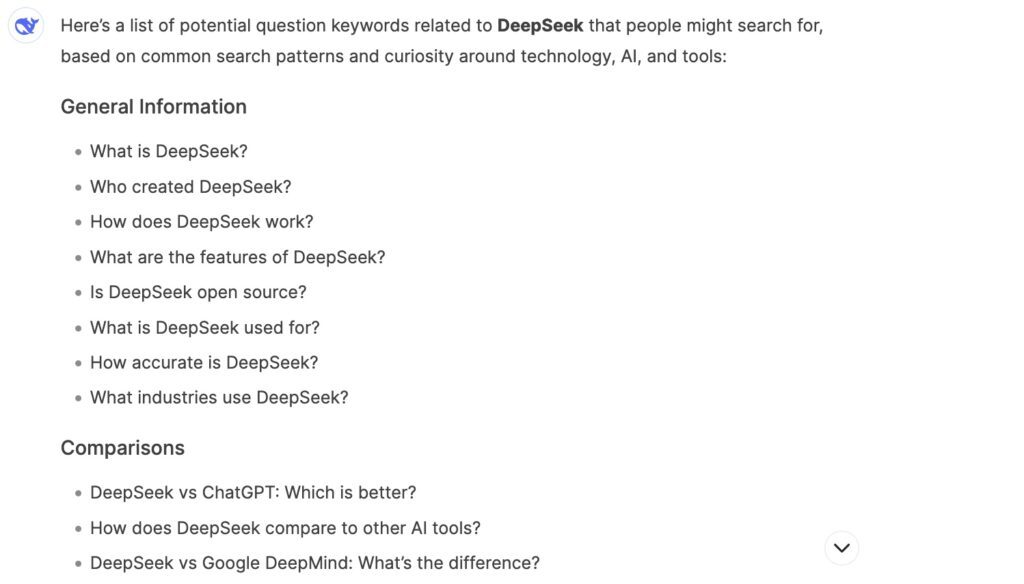
Several SEO and keyword research tools in the market deliver such comprehensive lists only with their paid plans. Considering this scenario, DeepSeek can help cut down marketing budgets spent on keyword research.
Finally, given the open-source structure of this tool, it’s easier to integrate it into existing SEO workflows to improve content marketing. Or even to create custom tools for content optimization.
Content ideation and generation
From brainstorming content ideas to generating content this AI tool can come in handy at various stages of content creation.
For instance, DeepSeek AI can help analyze what’s trending and what your competitors are discussing. This can give you valuable insights on what content strikes the right chord with your target audience.
For instance, when we asked for the currently trending topics in the marketing niche and some blog topic ideas based on these trends, DeepSeek generated a list based on diverse sources and brief explanations on why each trend matters.
The tool also generated intuitive blog topic ideas based on these trends identified from online sources. This can be a great starting point for content creators when they are stuck in a creative rut.

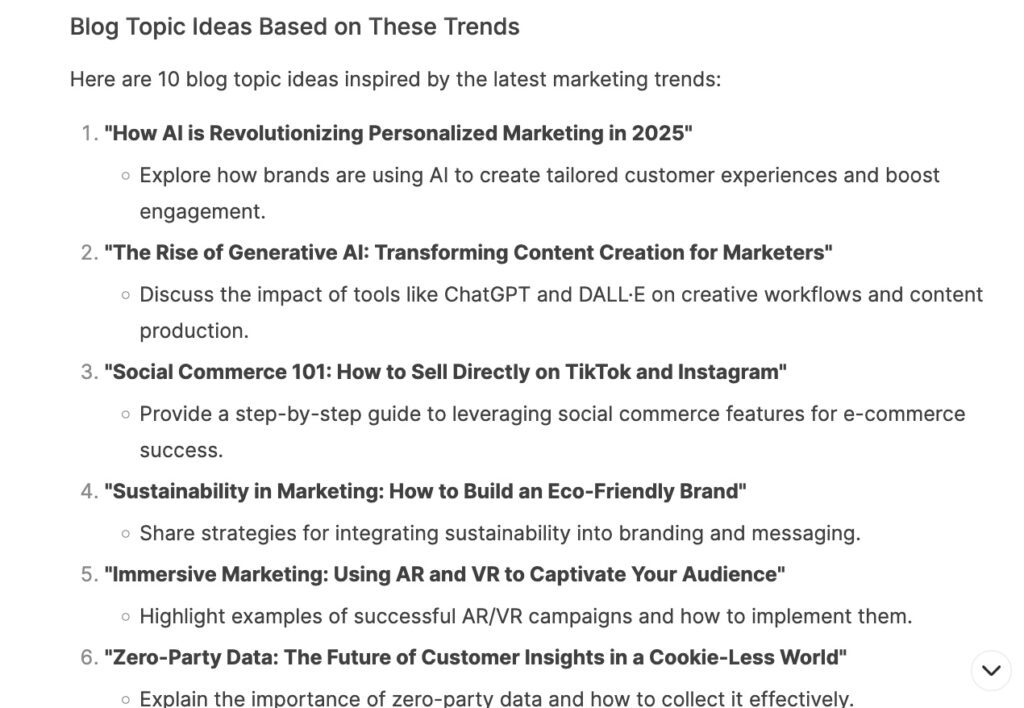
Furthermore, you can query the tool to give you a quick outline of what points to cover in your blog based on what people are searching for in that particular topic. This helps establish a direction for your content as well.
Not to forget, tools like these are particularly handy for those last-minute content needs like generating captions for your social media posts or a catchy copy for your ads.
Personalization
DeepSeek’s advanced natural language processing (NLP) and the reasoning capabilities of the DeepSeek-R1 model allow for real-time content optimization. Its ability to understand context and semantic relationships is key here. Therefore, marketers looking to boost their ROI by adopting a more personalized approach might benefit from this tool.
For instance, DeepSeek-R1, with its focus on reasoning, can infer user intent and preferences from real-time data, meaning that you can tackle nuanced content personalization.
Moreover, R1’s predictive analytics can help observe past user interactions and identify patterns to forecast intended parameters like optimal posting times for social media or even optimal times to send emails.
Timely response to customers
DeepSeek has been hailed for its natural language processing capabilities or NLP. this combined with the superior reasoning abilities of the R1 model can be used to create customer service chatbots. This helps marketers automate customer service and ensure timely responses to their customers.
DeepSeek can comprehend complex language structures, nuances, and contexts, which is crucial for interpreting user queries, feedback, or marketing content. Therefore, it can generate human-like text so that your chatbot appears less like a machine and more like a useful assistant to your customers.
Comparing DeepSeek With Popular AI Tools
ChatGPT vs. DeepSeek
ChatGPT and DeepSeek perform somewhat similarly when it comes to content creation.
For context, here are the responses we got from DeepSeek and ChatGPT for the same prompt.


Therefore, both tools are impressive when it comes to content creation. However, for more detailed data analysis and predictive modeling, DeepSeek might be a better choice than ChatGPT at the moment. In addition to giving you data-driven insights, DeepSeek with its open-source structure might be better suited for marketing automation.
But, ChatGPT’s extensive pre-built integrations with popular marketing platforms might make it easier to integrate into existing workflows.
One thing to remember is that some of the most advanced capabilities on ChatGPT are available only to paid users. Even the new features launched are often made available to paid accounts initially. (like the recent Tasks feature). However, with DeepSeek, all the features introduced so far are available for free.
As for the other basic features, this X user shared a detailed thread exploring various scenarios and how each tool responded in each case.
I tested ChatGPT-o1 and DeepSeek R1 with same critical prompts.
— God of Prompt (@godofprompt) January 31, 2025
The results will blow your mind.
ChatGPT-o1 Vs. DeepSeek R1
(Video demos are included) pic.twitter.com/8jZkM1dF7Z
Gemini vs. DeepSeek
Gemini and DeepSeek can both follow instructions accurately and generate content, analyze content and provide feedback or even help proofread your marketing copy. But yes, both display some inaccurate information here and there which is a common issue with most AI models.
When it comes to responses, each of these tools excels in different aspects. For example, we asked both these tools for recommendations on medium-budget smartphones in the U.S. market and here’s a glimpse of the responses we got.
The first image is the response from Gemini and the second is the response from DeepSeek. While DeepSeek does present more details in an organized fashion, Gemini provides direct links to stores for purchase.
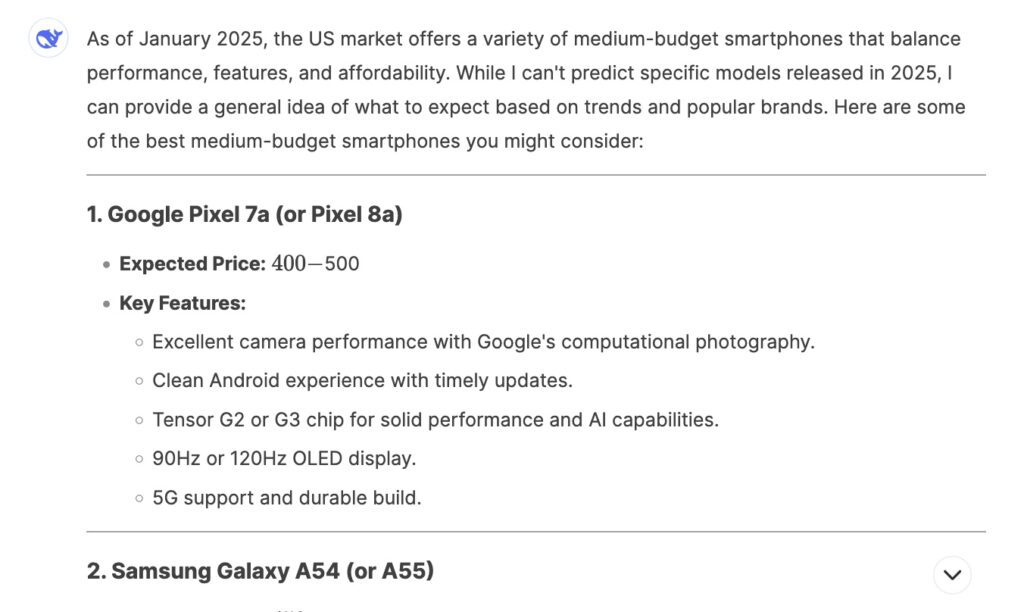
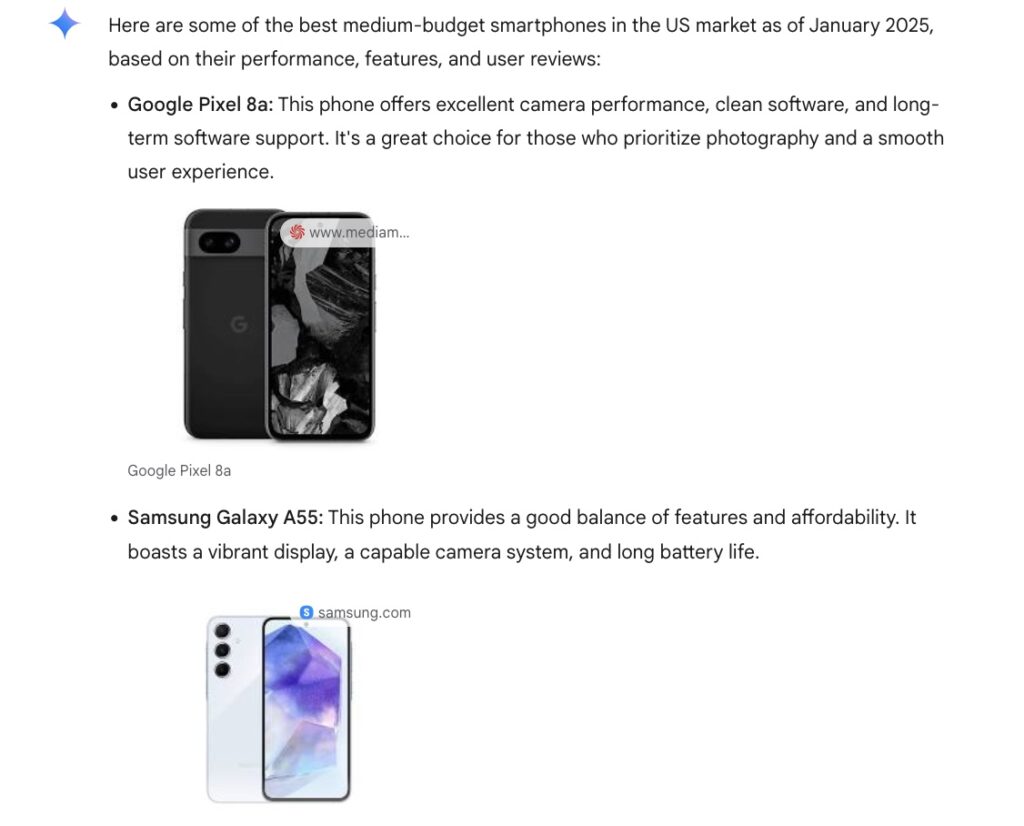
As for the reasoning abilities of both platforms, a creator compares the performance of DeepSeek R1 and Gemini Flash 2.0 in the video here. He highlights how Gemini seems to be slightly better than DeepSeek in this aspect.
The X post here summarizes the many parameters where Gemini seems to be better than DeepSeek.
everyone comparing deepseek-r1 to o1
— Dan Mac (@daniel_mac8) January 27, 2025
and forgetting about Gemini 2 Flash Thinking
which is better than r1 on every cost and performance metric pic.twitter.com/62V7dmAs7v
DeepSeek – Limitations to Anticipate
The cost-effectiveness and suddenness of its launch surprised the audience, no doubt. However, a lot of factors indicate that DeepSeek, despite being a worthy contender, is not essentially one that can dethrone the other existing players, just yet.
There are a few limitations we observed and some users who explored the tool seem to be talking about as well. Let’s look at a few of them.
Expect lags
If you have used diverse AI tools, you’ll find this one to be slightly sluggish. The tool can feel a little slow in terms of generating responses particularly when the responses are longer.
Moreover, when utilizing the “DeepThink-R1” and “Search” functions, the responses tend to be even slower.
In fact, some users on social media expressed their disappointment on how slow DeepSeek AI is in comparison with several other popular tools. The post here gives a snapshot of the number of output tokens per second which is indicative of the speed of the tool.
I am surprised how no one is talking about how slow DeepSeek is pic.twitter.com/I3PJNqyTTr
— PY (@peteryanni) January 27, 2025
The server seems to be busy most of the time
Data points to the fact that DeepSeek was trained on about 2000 GPUs. For perspective, OpenAI’s ChatGPT 4o was supposedly trained on 16000 GPUs. This indicates that DeepSeek operates with a fraction of the hardware used by tools like ChatGPT. Due to this and several other factors, DeepSeek AI seems to have less capacity to handle concurrent user requests.
As a result, you often see the “server is busy” prompt. This can be a turnoff for marketers looking to deploy tools like this to tackle last-minute requirements. Delays like these mean glitches in the workflow.
But yes, we cannot deny the fact that even some of the currently popular tools once faced a lot of server issues, particularly in their early days after launch. So, we’ll have to wait and see if these server-related issues with DeepSeek AI get resolved in the near future.
Image generation
Tools like ChatGPT, Gemini and the recently popular Grok now support image generation. This is one area where DeepSeek lags behind. Though it can analyze files, generating images is not an option as of now. So, if you are looking for a more comprehensive option for content generation, the paid versions on ChatGPT and Gemini might be better alternatives to DeepSeek.
Language mixing
This is a limitation described in one of the research papers from DeepSeek. Reportedly, since the model is designed to work with both Chinese and English, there tend to be language mixing problems now and then. Meaning that sometimes, part of the responses might not be in the same language as the query.
Prompt issues
Like all other AI tools, this one is as effective as the prompts you use. Meaning that you need to use the right prompts to get the best responses and to make the most of this tool. According to the research paper we discussed earlier, few-shot prompting where you give multiple examples to get the desired output can actually backfire. The company recommends using zero-shot prompting at the moment.
In fact, this is one area where this tool seems to be lagging behind contenders like ChatGPT and Gemini which are known to excel with few-shot prompting.
Security concerns
The one reason marketers are skeptical about adopting relatively new hypes like DeepSeek is data security and privacy. In fact, recent reports suggest that DeepSeek and several other AI tools are susceptible to AI jailbreaks.
This is a matter of concern because for organizations to truly tap into these AI tools, there should be a good organizational dataset based on which these models are trained. And in several cases, these tools will have access to real-time data. Therefore security vulnerabilities cannot be taken lightly.
The Verdict
If an expensive AI tool is not within your marketing scope and you still need to experiment with AI integration to enhance your marketing workflow, then DeepSeek is definitely a tool you cannot ignore. From quickly generating ideas for your content to helping you improve your marketing strategy, this tool can act as an efficient assistant. However, the server issues and delays are pretty significant. Even when we tried to explore the tool, we encountered the “server is busy” prompt most of the time. This can be highly inconvenient indeed.
Given these insights, the decision is yours. Will you integrate DeepSeek into your marketing workflow now, or would it be wiser to wait for further development, sticking with more established AI tools in the meantime?

